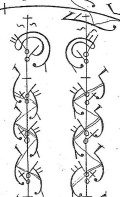There is another pas composé which appears in many of the stage dances for women, although Feuillet does not include it specifically in his step tables. This is how it is notated in the ‘Entrée pour une femme Dancée par Mlle Victoire au Ballet du Carnaval de Venise’, a forlane included in the 1704 collection of Pecour’s ‘Entrées de Ballet’ (plate 7):

The first element of the step is the same as Feuillet’s jetté ‘en avant et le second emböetté derriere’ (Choregraphie, pl. 72).

This particular jetté is the basis for Feuillet’s ‘demie cabriole en avant’, which he also calls a ‘jetté battu’ (Choregraphie, pl.84).

In the women’s dances, it is notated as a jetté, without the third line that denotes the cabriole movement, the beating together of the legs in the air.
The demie cabriole is one of the few theatrical steps to get a mention in Pierre Rameau’s Le Maître a danser of 1725, in his chapter XXXVI ‘Des Jettez, ou demies Cabrioles’ (the translation is by John Essex, from The Dancing-Master of 1728, p. 96)
‘They [jettés] are yet made after another Manner which requires more Strength in the Spring, Quickness in the Rise, and Extension of the Legs, striking them one against the other, falling on the contrary Foot to that sunk upon, and then change their Names and are called half Capers: But as these are Steps for the Stage, and in this Treatise I undertook to teach the Manner of making Steps used in Ball Dancing, I shall not trouble my Reader with these latter, which are only for those whose Form is exquisitely nice, and who make Dancing their Business.’
We might assume that Rameau (as well as his translator) refers to male professional dancers, but he does not specifically say so.
So, where does this jetté ‘emböetté’ appear in the solos and duets for women within the three collections I am looking at? The other solo dance in the Pecour collection of 1704 which includes it is Mlle Subligny’s ‘Gigue pour une femme’, to music from Gatti’s Scylla, first in bar 22 (plate 43, shown below) and again in bar 34 (plate 44).

She starts with the right foot the first time and the left foot when the step reappears. Both times it is preceded by a pas de bourée emboîté and followed by a coupé battu. The step is embedded within a repeated 12-bar sequence of steps danced to the first and second repeats of the B section of the music.
It also occurs in the one duet in the 1704 collection, the forlane danced by Mlle Victoire and Mlle Dangeville in the Ballet des Fragments de Lully (bar 17, plate 53).

Here, it is preceded by an assemblé / pas simple combination and followed by a coupé battu.
The jetté emboîté occurs in three of the women’s solos in Pecour’s Nouveau recüeil of around 1713. The first is the ‘Gigue pour une femme seul’ from Campra’s Tancrède (bar 18, plate 75), danced by Mlle Guyot.

Here, it follows a contretemps backwards and is followed by a coupé battu.
In the ‘Passacaille pour une femme’ danced by Mlle Subligny to music from Lully’s Armide it appears twice. First in bar 62 (plate 82, shown below left), where it is preceded by a pas de bourée and followed by a coupé battu, then in bar 74 (plate 83, shown below right), where it follows a pas de bourée emboîté. This second time, the concluding pas simple becomes a pas plié and the dance bar ends with a coupé avec rond de jambe.


This proto-cabriole turns up in both the canary duets for women in this collection. In the ‘Canarÿe’ it occurs twice, first in bar 10 (plate 43, see below top), where it is preceded by a pas de bourée emboîté and followed by a coupé battu. The second time, in bar 38 (plate 45, see below bottom), it begins the final musical section after the assemblé / pas simple which finishes a pas de rigaudon and is followed by a coupé battu.


In the ‘Entrée de deux Bacchante’, like the ‘Canarÿe’ danced by Mlle Guyot and Mlle Prévost, it also begins the final musical section (bar 26, plate 63) and is preceded by a pas de bourée and followed by a coupé battu.

In his New Collection of around 1725, L’Abbé’s ‘Passagalia of Venüs & Adonis’ provides Mrs Santlow with several variants on the basic jetté emboîté which I will discuss in another post. In the ‘Passacaille of Armide’ danced by Mrs Elford and Mrs Santlow, this proto-cabriole comes in bar 100 (plate 13), immediately preceding the assemblé battu which closes the musical variation. It is preceded by a pas composé comprised of a coupé to first position, a pas plié and a jetté. And, as you see, there are three of these variant jettés emboîtés in the bar rather than the more usual two.

Like the pas de sissonne battu, this jetté emboîté is a commonplace in stage dances for women. Should we make anything of the fact that in the majority of the dances by Pecour it is followed by coupé battu? If nothing else, it seems to point to one of his favoured choreographic devices.
Why have I dealt with this topic at such length? Am I the only one who has danced all these choreographies to wonder whether the jetté emboîté should really be a demie cabriole? The female professional dancers for whom these dances were created undoubtedly had the strength and the technical skill to perform cabrioles, which would have been clearly seen under the shorter skirts we know they wore. Did the notations follow a convention related to the one that routinely depicts leading ballerinas in floor-length skirts? I believe they did.









